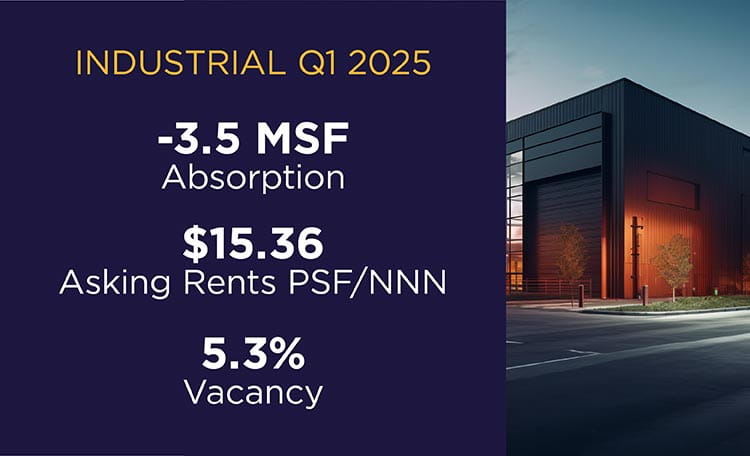A Continued Upward Trend in Industrial Vacancy in Q1 2025
In its March 2025 Labour Force Survey, Statistics Canada reported that after seven consecutive months of job growth employment fell by 33,000 from last month with the unemployment rate increasing by 10 basis points (bps) from February 2025 to 6.7%. More than likely current economic challenges, driven in part by recent trade disruptions, will impact the labour market through the remainder of the year.
The overall Canadian industrial vacancy rate bumped up by 50 bps quarterover- quarter (QOQ) to reach 5.3%. Most of major Canadian markets witnessed vacancy increases QOQ, albeit minor, ranging from 20 to 30 bps. The exception to this was Montreal which continues to face headwinds with vacancy trending upwards at a notable pace, now sitting at 7.4%, a 110 bps increase from last quarter. Despite the overall Canadian vacancy rate posting at times notable QOQ increases since the second half of 2023, the market is now in what can be considered more balanced market conditions; providing numerous space options for occupiers to expand or relocate, without in turn resulting in asking rental rates to soften in a dramatic fashion.
The amount of industrial vacant space on the market now sits at 107.7 million square feet (msf), approximately 18.2 msf higher than last quarter. This increase was driven entirely by the arrival of new vacant direct space, as the amount of sublet vacancy was almost unchanged from the previous quarter. A relatively small component of this new direct vacancy was a result of new supply that was delivered this quarter which had approximately 3.6 msf of vacancy. Instead, a significant component of the new vacancy has continued to be in the form of large blocks of space, i.e. over 50k square feet (sf) in size, a size range that is currently experiencing weaker demand and will take some time to be re-absorbed into the market.

After two quarters of positive absorption, absorption turned sharply negative in Q1 2025 reaching close to negative 3.5 msf. It is worth noting this underlying weakness is not widespread. Vancouver and Toronto absorption figures were positive this quarter, and in Calgary - despite being in negative territory this quarter- the total amount was relatively minor. Instead, it was the continued softening in the Montreal market that was the driving factor with negative 4.6 msf of absorption this quarter. It is anticipated the Montreal market will have some improvement to absorption through the remainder of 2025 and in turn will help boost absorption levels for the overall country.
Overall leasing activity has remained steady, hovering around the 12.2 msf mark for the third straight quarter. The overall average lease size in the major markets was close to 20k sf this quarter, although that average bumps up a bit when looking at deals completed in buildings that were either built after 2020 or are currently construction – averaging around 53k sf. The overwhelming majority of leasing transactions this quarter were under 25k sf in size, with the number of deals that were over 125k sf in size only accounting for 3.3% of the total count. The breakout of this activity helps to illustrate that while activity has fallen off for large-bay space, many markets are continuing to see demand for smaller to medium bay product.
New supply arrivals reached 5.8 msf this quarter, largely located within the GTA and Vancouver markets. Approximately 77% of the completed buildings were built on a speculative basis, and when delivered added about 3.6 msf of new vacancy to the overall market this quarter. From a size perspective, the majority of buildings that were completed this quarter were under 300k sf, with four projects ranging in size from 300k sf to 500k sf. This marks a bit of a departure from one-year-ago, where there were two projects delivered ranging from 500k sf to 1.0 msf, and two projects over 1.0 msf. While there remains an additional 21.7 msf that is currently under construction, it has slowed by about 36.4% in comparison to the amount of square footage under construction one year ago. Of the square footage under construction 18.5 msf of that total is set to be delivered by the end of 2025. Like the completions this quarter, the majority of the projects are speculative and currently are approximately 30% preleased which may bump up overall vacancy slightly if no additional preleasing is completed.
The overall asking average net asking rental rate continued to decline to reach $15.36 per square foot in Q1 2025, approximately 3.0% lower than last quarter and 7.6% lower than one-year-ago. A decline in rates in Calgary and Montreal were the primary drivers behind the overall decrease this quarter, as rates in Vancouver and Toronto were almost unchanged from Q4 2024.





